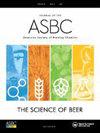Can Cider Chemistry Predict Sensory Dryness? Benchmarking the Merlyn Dryness Scale
IF 1.8
4区 农林科学
Q4 BIOTECHNOLOGY & APPLIED MICROBIOLOGY
Journal of the American Society of Brewing Chemists
Pub Date : 2022-10-12
DOI:10.1080/03610470.2022.2121562
引用次数: 2
Abstract
Abstract The growing popularity of hard cider in the United States has been accompanied by an inconsistent understanding of the nature and importance of consumers’ perception of dryness and sweetness in the product. In 2018, the New York Cider Association proposed the Merlyn Dryness Scale as a tool to predict cider dryness using basic cider chemistry, but this approach has yet to be validated in sensory experiments. In the current study, panelists (N = 48) evaluated three different commercial ciders served at two different temperatures (2 °C and 22 °C) in three parts: by rating the dryness of the sample on a line scale equivalent to the range of the Merlyn Dryness Scale, by using a simple check-all-that-apply (CATA) tool that included dryness, and by rating their overall liking on a 9-point hedonic scale. The results indicated that the Merlyn Dryness Scale may not achieve its goal of predicting perceived dryness in cider, as consumers perceived cider samples to be more dry than was suggested using Merlyn Scale chemical procedures. Contrary to expectations, the serving temperature of the cider samples did not significantly impact perceived dryness rating but did influence overall liking. This study suggests that predicting sensory dryness from cider-chemistry parameters requires further study.苹果酒的化学成分能预测感觉干燥吗?梅林干燥度量表的基准测试
随着硬苹果酒在美国的日益流行,消费者对产品中甜度和干度的感知的性质和重要性的理解并不一致。2018年,纽约苹果酒协会(New York Cider Association)提出了梅林干度量表(Merlyn dry Scale),作为使用苹果酒基本化学成分预测苹果酒干度的工具,但这种方法尚未在感官实验中得到验证。在目前的研究中,小组成员(N = 48)评估了三种不同的商业苹果酒在两种不同的温度(2°C和22°C)下的三个部分:通过在相当于梅林干燥度量表范围的线量表上对样品的干燥度进行评级,通过使用包括干燥度的简单检查(CATA)工具,以及在9分的享乐量表上对他们的总体喜欢度进行评级。结果表明,梅林干燥度量表可能无法达到预测苹果酒感知干燥度的目标,因为消费者感知的苹果酒样品比使用梅林尺度化学程序建议的更干燥。与预期相反,苹果酒样品的服务温度并没有显著影响感知干度评级,但确实影响了总体喜欢度。这项研究表明,从苹果酒的化学参数预测感官干度需要进一步的研究。
本文章由计算机程序翻译,如有差异,请以英文原文为准。
求助全文
约1分钟内获得全文
求助全文
来源期刊

Journal of the American Society of Brewing Chemists
工程技术-生物工程与应用微生物
CiteScore
4.00
自引率
20.00%
发文量
41
审稿时长
3 months
期刊介绍:
The Journal of the American Society of Brewing Chemists publishes scientific papers, review articles, and technical reports pertaining to the chemistry, microbiology, and technology of brewing and distilling, as well as the analytical techniques used in the malting, brewing, and distilling industries.
 求助内容:
求助内容: 应助结果提醒方式:
应助结果提醒方式:


